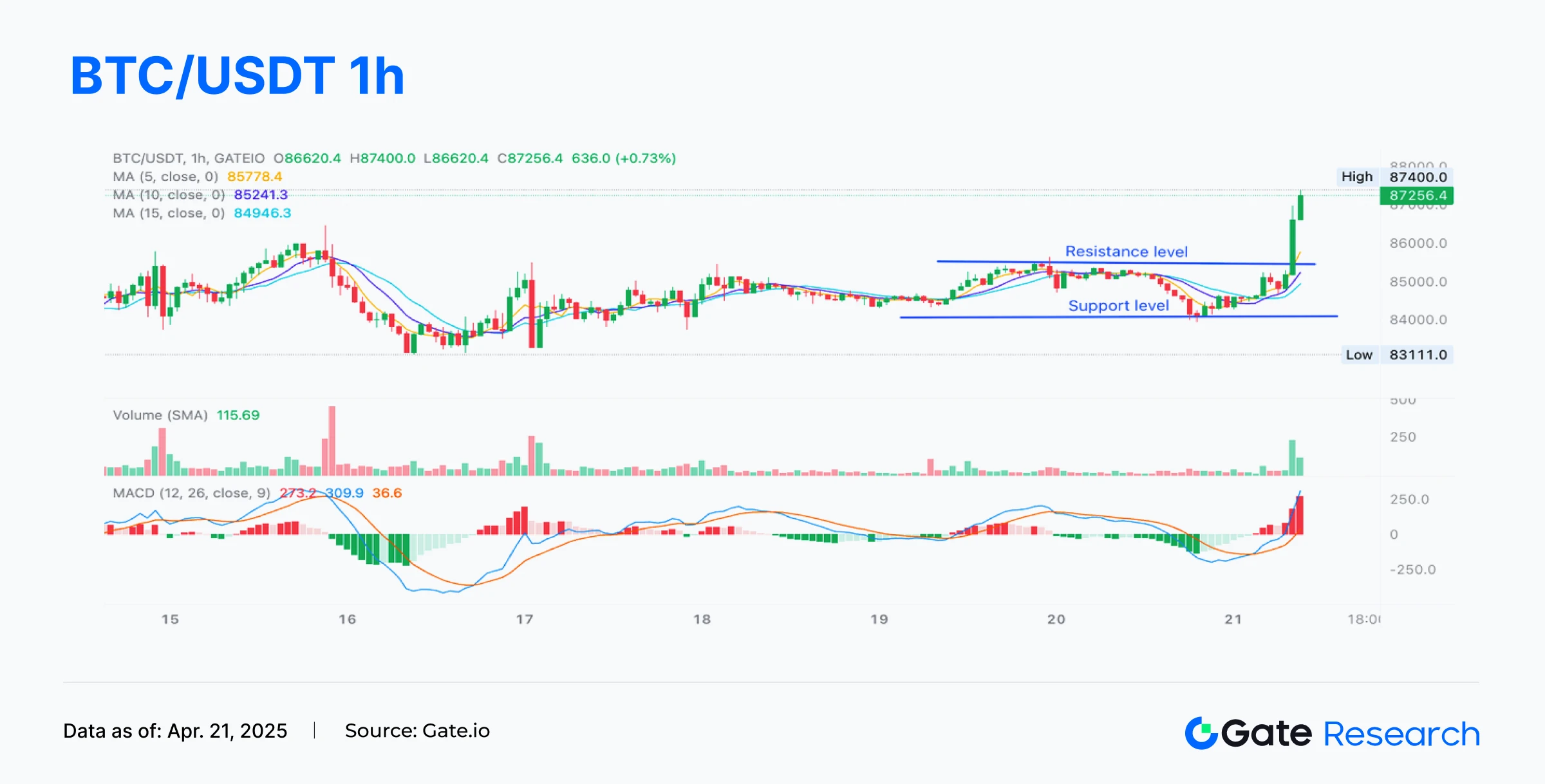Gate Research: BTCが$85,800の価格水準を突破、VitalikがRISC-Vを提案してEthereumのパフォーマンスを向上させる
Gate Research Daily Report: 4月21日、Bitcoinは2.4%上昇して87,400ドルに、Ethereumは0.49%増の1,631ドルになり、市場のセンチメントが徐々に回復しています。Vitalik ButerinはEVMをRISC-Vで置き換えることを提案し、それによりEthereumの実行レイヤーに新たな技術革命の波が訪れる可能性があります。Canary CapitalはステーキングされたTRX ETFの承認を求めており、これは暗号資産が従来の金融システムに加速度をつけて統合されていることを示しています。世界的な小売り大手のSPARはスイスで暗号通貨の支払いを実験しており、実世界でのユースケースをさらに拡大しています。Hyperliquidはオンチェーンデリバティブ市場で急速に台頭し、市場シェアの70%近くを占めています。Tetherの利用者は4.5億人を超え、ステーブルコインの成長は堅調なままです。抽象
- Bitcoinは2.4%上昇して87,400ドルに上昇しました。イーサリアムは0.49%上昇して1,631ドルに上昇しました。
- Vitalik Buterinは、EVMをRISC-Vで置き換えて、Ethereumの実行レイヤーを大幅にスケーリングすることを提案しています。
- Canary Capitalは、米国証券取引委員会にTRXステーキングETFの申請を提出します。
- 世界的な小売業者SPARは、スイスで仮想通貨決済をテストしています。
- Hyperliquidはオンチェーンの永続契約市場の約70%を獲得しています。
- Tetherユーザーは4億5000万人を超え、四半期ごとのユーザー数は3000万人以上増加しています。
市場分析
- BTC—— ビットコインの価格は過去24時間で2.4%上昇し、現在87,400ドルで取引されています。BTCは以前の相場の範囲を突破し、以前の抵抗レベルである約85,800ドルを断然に超え、取引量の大幅な増加とともに強気の勢いを示しています。サポートレベルは約84,000ドルで、価格は何度もテストして突破に失敗し、確固とした底を確認しています。MACDインジケーターのゴールデンクロスの後、ボリュームは増加し続け、勢いのバーは大幅に上昇しています。短期トレンドは相場から上昇に変わりました。価格が高いボリュームレベルで一貫して86,000ドルを超え続けることができれば、90,000ドルを目指す可能性が高いです。ボリュームの収縮と反動が起こった場合、84,000ドルでのサポートの有効性に注意する必要があります。[1]

- イーサリアム—— イーサリアムの価格は過去24時間で0.49%上昇し、現在の価格は$1,631です。数日の相場の停滞の後、ETHは今日$1,630前後の抵抗に接近し、牛の力が再び現れました。サポートレベルは$1,580前後で、価格は何度も安定し、強力な底値サポートを形成しています。ブレイクアウトには取引量の大幅な増加が伴い、強力な牛の勢いと上昇の技術的バイアスを示しています。MACDもゴールデンクロスを形成し、赤い棒が続く中でさらなる上昇の可能性を示唆しています。価格が引き戻されても$1,600〜$1,580のサポート範囲を保持すれば、ブレイクアウトが確認され、$1,660や$1,680の高値地域でさらなる挑戦が予想されます。[2]

- ETF—— SoSoValueによると、4月17日、米国の現物ビットコインETFは約1.07億ドルの純流入を記録しました[3];同日、米国の現物イーサリアムETFは純流入額が0ドルでした。データは4月21日12:00PM(UTC+8)時点のものです[4]。
- オルトコイン—— ビットテンソルエコシステム、ビットコインサイドチェーン、およびAIエージェントランチパッド部門はそれぞれ+15.1%、+8.3%、および+7.2%上昇しました[5]。
- 米国株指数——4月17日、S&P500指数は0.13%上昇し、ダウ平均は1.33%下落し、ナスダックは0.13%下落[6]。
- スポットゴールド—— スポット金は日中1.67%上昇し、オンス当たり3,383.02ドルに達しました。4月21日12:00午後(UTC+8)のデータ[7]。
- 恐怖と欲望指数——フィアアンドグリード指数は39で、恐怖感の状態にある市場を示しています[8]。
トップパフォーマー
Gate.ioの市場データ[9]によると、過去24時間で取引高と価格変動を基にしたトップのパフォーマンスを発揮したオルトコインは以下の通りです:

MAGIC (Magic)—— 約39.30%の日次利益率で、時価総額は約$57.96百万ドルです。
Magic(MAGIC)は、Arbitrumをベースにした分散型ブロックチェーンゲームエコシステムで、コミュニティ主導の「ゲームメタバースネットワーク」の構築を目指しています。さまざまなオンチェーンゲーム、NFTプロジェクト、物語の世界を相互接続されたエコシステムに接続します。Treasureエコシステムは、ゲーム開発をサポートするためのインフラストラクチャ、マーケットプレイス、ツールを提供し、プレイヤーが複数のプロジェクト間で資産と経済システムを共有できるようにします。その基本理念は、オープン性、分散化、コミュニティ主導の開発を強調し、「ブロックチェーンゲームの任天堂」というニックネームを獲得しています。
最近、Treasureは、AIスペースに焦点を当てた新しいロードマップを公開し、NFTと人工知能の深い統合を示しています。ユーザーのL1 NFTは、カスタマイズ可能なAIコンパニオンに変身し、ソーシャルメディアアカウントにリンクし、ゲームやミッションに自動的に参加して報酬を獲得し、最終的には専用ウォレットを介して取引ややり取りを実行することができるようになります。AI、DeFi、NFT、GameFiの交差点で運営されるTreasureは、MAGICの有用性と価値を向上させ、そのエコシステムに対する市場の期待を大幅に高め、投資家を惹きつけ、MAGICの価格を押し上げています[10]。
USUAL (Usual)—— 約36.11%の日次利益、時価総額約12.7億ドル。
Usual(USUAL)は、革新的なアルゴリズムとスマートコントラクトを通じて安全で透明で効率的な金融取引環境を提供するよう設計された、ブロックチェーンベースの分散型ファイナンスプラットフォームです。その中心目標は、ユーザーが分散型ファイナンス(DeFi)活動に参加しやすくすることであり、従来の金融システムの高コストと非効率性に対処しています。分散型の自動マーケットメーカー(AMM)メカニズムを活用することで、Usualはさまざまなデジタル資産の流動性プールをサポートし、ユーザーが取引、貸出、ファーミングなどを行う一方、資産のセキュリティとプライバシーを確保しています。
先週の火曜日から、すべての新しい早期償還手数料およびUSUALxのアンステーキング手数料は、自動的にステーカーに毎日再分配され、それにより年間利回り(APY)が直接増加しています。このメカニズムにより、従来の遅延や提案段階がなくなり、USUALxの保有者にリアルタイムで報酬が分配されるため、ステーキングのリターンが大幅に向上しています。この効率的で透明な報酬モデルは、より多くのユーザーがステーキングに参加することを奨励し、それによりUSUALxの需要と価格の上昇をさらに推進しています。
ENJ (ENJ)—— デイリー利益率は約30.10%で、流通市場価値は163百万ドルです。
Enjinは、開発者、企業、個人がNFTを簡単に作成、管理、取引、配布、統合するのを支援するさまざまなソフトウェア製品を提供する包括的なブロックチェーンエコシステムです。
Enjinは最近、NFT.ioで「Enjin Snap Challenge」を開始しました。このキャンペーンは、ユーザーにEnjinのdAppsとの関わりを促し、エクスクルーシブなENJ注入レアNFTを賞品として提供しています。このようなイベントは、Enjinエコシステム内のエンゲージメントとアクティビティを増やし、ENJトークンとNFTのユーティリティと接続を強調します。これにより、コミュニティからの注目と参加が集まり、最近のENJ価格の急上昇に貢献しています。
データのハイライト
ハイパーリキッドは、オンチェーン永続契約市場の約70%を獲得しています
Hyperliquidは最近、分散型永続契約市場で大きな進展を遂げ、市場シェアの約70%を獲得しました。3月だけで取引高は1750億ドルを処理し、4月中旬にはすでに1,226億ドルに達していました。主要な中央集権取引所と比較すると、Hyperliquidの取引高は彼らのほぼ10%に達し、分散型デリバティブ取引の強力な成長を示しています。[13]
永続先物は、期限切れがない構造、レバレッジサポート、高い流動性などにより、トレーダーによって長らく支持されてきました。Hyperliquidは分散型スマートコントラクトの実行メカニズムを活用して取引の透明性と自動化を向上させる一方、清算問題や管理リスクなど中央集権取引所に関連する一般的なリスクを効果的に緩和します。
市場シェアは印象的ですが、最近の出来事により、Hyperliquidのリスク管理とセキュリティについて懸念が広がっています。たとえば、プラットフォーム上のJELLYトークンが複雑な市場操作事件に関与し、1000万ドル以上の損失をもたらしました。さらに、北朝鮮のハッカーグループに関連するウォレットアドレスがHyperliquidで活動しており、セキュリティの脆弱性をテストしている可能性が報告されています。これらの出来事は、Hyperliquidが急成長する中で直面する課題を浮き彫りにしており、特にリスク管理とサイバーセキュリティにおける挑戦を強調しています。

Tetherが450百万人を超え、四半期ごとに3000万人以上のユーザーを追加
Tetherは、安定したコインUSDTが新興市場で4億5000万人以上のユーザーを持っていることを発表しました。そのうちの大部分は、トルコ、ベトナム、ブラジル、アルゼンチン、およびいくつかのアフリカ諸国に拠点を置いています。この安定したコインは、四半期ごとに3000万人以上の新しいユーザーを追加しており、急速な世界的な採用を示しています。TetherのCEOであるPaolo Ardoino氏は、USDTが新興市場で最も広く使用される「デジタルドル」となりつつあると述べ、それが暗号通貨取引だけでなく、日々の支払いや貯蓄にますます使用されていることを示しています。
USDTの広範な採用は、経済の不安定さを抱える地域で便利なドルの代替手段としての有用性に起因しています。アルゼンチン、トルコ、エジプトなどの国々では、現地通貨が価値を失い、米ドルが不足しているため、人々はUSDTを貯蓄や取引に利用しています。たとえば、ブラジルでは、TetherはATM運営会社と提携し、USDTを24,000台以上のATMで利用可能にすることで、その利用が大幅に向上しました[14]。
米国などの主要経済が輸入関税を頻繁に調整し、継続的な地政学的緊張が伝統的および暗号金融資産の双方に対する信頼を揺さぶる中、リスク回避のために大量の資本がステーブルコインに流入しています。米ドルにペッグされた暗号資産として、USDTの安定した価値と利便性は、取引リスクに対処し資産を保護したい企業や個人にとってトップチョイスです。このユーティリティは、異なる地域で信頼性の高い金融ツールへの重要な需要を満たし、米ドルの世界金融システムにおける支配を一層強固にし、USDTの爆発的なユーザー成長に貢献しています。

ビットコインネットワークの難易度が新しい歴史的な高値を記録し、ハッシュレートは引き続き上昇しています
2025年4月19日17:13:37、ブロック高893,088で、ビットコインネットワークは新たな難易度調整ラウンドを完了しました。今回の調整では1.42%の増加が見られ、マイニング難易度は123.23Tに上昇しました - ネットワークの歴代最高値です。一方、ネットワークの平均ハッシュレートは888.37 EH/sに上昇し、ネットワーク全体での参加が着実に増加していることを示しています[15]。
ビットコインのマイニング難易度は、約2週間ごと(2,016ブロックごと)にネットワークのハッシュレートの変化に基づいて自動的に調整され、10分ごとに1ブロックを維持するためです。この調整は、増加の一環としてさらなる増加を示唆しており、マイナーの数が増加しているか、マイニングハードウェアの効率が向上している可能性があります。次の難易度調整は、約13日21時間後に予定されており、そのときネットワークは再び現在の状況にダイナミックに応答するでしょう。
最近のビットコイン価格の急反発とスポットETFからの資本流入により、難易度は増加し、採掘の収益性が向上し、大幅なハッシュレートのオンライン復帰をもたらしました。さらに、北アメリカと中東の大規模な採掘施設での拡張や、チップのエネルギー効率の向上も、ハッシュレートの上昇に貢献し、間接的に難易度を高めています。
スポットライト分析
スイスで暗号通貨決済をテストするグローバル小売業者SPAR
SPARは現在、スイスで仮想通貨決済の試験を行っています。ヨーロッパ、アジア、アフリカ、オーストラリアの48カ国で13,900店舗以上を展開するグローバルな食料品小売ブランドであるSPARは、スイスのツークにある店舗でライトニングネットワークを介したビットコイン決済を受け付けています。この試験は、主要小売チェーンによる暗号通貨決済の最も重要なテストの1つです[16]。
このパイロットは、高速で低コストのマイクロトランザクションを可能にするライトニングネットワークの利点を活用しています。お客様は、ライトニング対応のウォレットを使用してQRコードを簡単にスキャンして支払いを完了することができ、従来のクレジットカード取引よりも手数料が大幅に低く、ほぼ即時の決済が行われます。暗号通貨に対する友好的な姿勢で知られるスイスでは、既に230を超える店舗がライトニング決済を受け入れており、チューグの「クリプトバレー」がこのトレンドの中心に位置しています。
SPARの動きは、増加する暗号通貨保有者を受け入れるための興味と、デジタル決済手段の探索に対する関心の高まりを反映しています。この試験運用は、主流小売業における暗号通貨決済の実現可能性と需要を評価するために、十分に監視される可能性があります。VisaやStripeなどの決済大手が徐々に暗号空間に参入するにつれて、ライトニングネットワークはグローバル決済インフラの重要な部分になる可能性があり、ビットコインの進化を「デジタルゴールド」から「デジタルキャッシュ」へと推進することになるかもしれません。
Canary Capitalが米国証券取引委員会に対してStaked TRX ETFの発売を申請
Canary Capitalは、米国証券取引委員会(SEC)に申請を提出し、ステーキングされたTRONトークン(TRX)に基づく現物取引所取引型ファンド(ETF)の承認を求めています。この「Canary Staked TRX ETF」と名付けられた製品には、米国の暗号通貨ETF市場にとって画期的なトークンステーキング機能が組み込まれる予定です。さらに、Canary Capitalは、Pengu、Sui、Hedera、およびLitecoinなどの資産にリンクした一連の他の暗号通貨ETFを検討していると報じられています。
TRONブロックチェーンのネイティブトークンであるTRXは、安定したステーキングメカニズムと幅広いユースケースを備えており、安定した収益を求める機関投資家に魅力的です。ただし、SECは通常、関連資産に連邦規制先物市場が必要としており、この基準をTRXはまだ満たしていません。また、SECはまだTRXに関連するETFを承認しておらず、これには規制上の障壁がある可能性があります。
ドナルド・トランプが今年1月に米国大統領に就任して以来、SECは暗号通貨業界に対してよりオープンな姿勢を示しています。SECは複数の公開暗号通貨ラウンドテーブルを開催し、複数の暗号通貨企業に対する訴訟を取り下げています。このETFが承認されれば、暗号通貨ETF市場でさらに重要な節目となり、ステークされた暗号通貨資産への機関投資家の注目を引き、TRXの採用とTRONエコシステムの成長を加速する可能性があります。さらに、これにより他の暗号資産発行者が同様の製品を迅速に進めるきっかけとなり、暗号通貨ETF市場の多様化に貢献するかもしれません。ただし、規制上の不確実性により、市場参加者はSECの審査プロセスと関連する政策の動向を注視すべきです。
Vitalik Buterinは、EVMをRISC-Vに置き換えて、Ethereumの実行レイヤーを大幅にスケーリングすることを提案
イーサリアムの共同創設者であるVitalik Buterinは最近、イーサリアムマジシャンフォーラムで新しい長期技術イニシアチブを提案しました。それは、現在のバイトコードベースのアーキテクチャからオープンソース命令セットRISC-Vに移行するというものです。彼は、この変更が実行レイヤーの大幅なパフォーマンス向上を実現するための「唯一の実行可能な道」を表しており、オンチェーンの実行コストを最大100倍削減できる可能性があると述べています。
RISC-Vは、シンプルさと効率性を目的としたオープンソースのリデュース命令セットアーキテクチャ(RISC)であり、ライセンスなしで誰でも実装できるよう設計されています。その設計は、スムーズなチップアーキテクチャ、複雑さの削減、最適化されたハードウェア-ソフトウェアの相互作用を促進しています。開発者は、現在のEVMはコスト効果があるが、実行リスクが高いと指摘しています。したがって、Vitalikは、より安全で検証可能なEVMのバージョンを作成するために、RISC-Vをビーコンチェーンに実装することを提案しています[18]。
RISC-Vのオープン性とモジュラリティを活用することで、Ethereumの開発者はEVMの動作を形式的に検証でき、ネットワークのセキュリティと安定性を向上させることができます。単純化されたアーキテクチャにより、開発および保守コストが削減され、システムの拡張性が向上します。ただし、このような変革は既存のインフラの適応や現行のスマートコントラクトとの互換性確保などの課題をもたらす可能性があります。それでも、RISC-Vの採用により、Ethereumはパフォーマンスとセキュリティを向上させ、ブロックチェーン領域でさらに強力になることができます。
エアドロップの機会
Recallは、分散型の知的ネットワークであり、自律型AIエージェント向けのオンチェーン知識ストレージ、共有、および交換プラットフォームとして機能するよう設計されています。このプロジェクトは、3Box LabsとTextileの合併から生まれ、CeramicやTablelandなどの技術を統合し、許可なしのAIデータコラボレーションエコシステムを構築しています。Recallは、AIエージェント間の検証、トレーニング、および収益化を可能にし、分散型AIアプリケーションの開発を推進しています[19]。
Recallは、Multicoin CapitalやCoinbase Venturesなどの機関から支援を受けています。ユーザーがテストやタスクに参加することを奨励するために、ポイントベースのインセンティブプログラムを立ち上げました。将来のエアドロップリワードの可能性もあります。
参加方法:
- Recallの公式ウェブサイトを訪れ、ウォレットを接続し、タスクポータルを閲覧して現在のタスクについて学びます。
- GalxeのRecallキャンペーンページにアクセスし、ソーシャルメディアアカウントのフォローや相互作用への参加などのタスクを完了してください。
- Zealyでのタスクを完了し、投稿のリツイートやDiscordサーバーへの参加などのアクションを実行します。
- DiscordでGenesisの役割を獲得するには、アクティブであり、新しいメンバーを助けたりコンテンツを作成したりする必要があります。この役割はあなたのポイントを増やします。
- Recallの競技に適したAIエージェントを発見した場合、追加ポイントを得るためにそのX(Twitter)ハンドルを提供して提出できます。
- タスクを完了したら、ポイントが正しく記録されていることを確認するために、バッジを請求するためにプラットフォームに戻ります。
注意:
エアドロップ計画と参加ルールは変更される可能性があるため、ユーザーは最新情報を入手するためにRecallの公式チャンネルに注意を払うことをお勧めします。ユーザーは慎重に参加し、リスクを認識し、事前に十分な調査を行う必要があります。Gate.ioは将来のエアドロップリワードの分配を保証しません。
参照:
- Gate.io,https://www.gate.io/trade/BTC_USDT
- Gate.io,https://www.gate.io/trade/ETH_USDT
- SoSoValue,https://sosovalue.xyz/assets/etf/us-btc-spot
- SoSoValue,https://sosovalue.xyz/assets/etf/us-eth-spot
- CoinGecko,https://www.coingecko.com/ja/categories
- 投資する,https://investing.com/indices/usa-indices
- 投資,https://investing.com/currencies/xau-usd
- Gate.io,https://www.gate.io/bigdata
- Gate.io,https://www.gate.io/price
- X,https://x.com/mikelauofficial/status/1913483120156057777
- X,https://x.com/usualmoney/status/1913255420430630981
- X,https://x.com/enjin/status/1912106308016460030
- ザブロック,https://www.theblock.co/post/351051/hyperliquid-grabs-70-market-share-in-onchain-perps-signaling-shift-from-centralized-derivatives
- X,https://x.com/paoloardoino/status/1913256690633392378
- Cloverpool,https://explorer.cloverpool.com/zh-CN/btc/insights-difficulty
- Linkedin,https://www.linkedin.com/posts/rahimt_first-bitcoin-payment-at-a-supermarket-in-activity-7317931663441723392-ZuYb/
- ザブロック,https://www.theblock.co/post/351289/canary-capital-seeks-sec-approval-for-staked-trx-etf?utm_source=twitter&utm_medium=social
- マジシャン、https://ethereum-magicians.org/t/long-term-l1-execution-layer-proposal-replace-the-evm-with-risc-v/23617
- X,https://x.com/recallnet/status/1905259039392493669
ゲートリサーチ
Gate Researchは、テクニカル分析、ホットな情報、市場レビュー、業界調査、トレンド予測、マクロ経済政策分析を含む、包括的なブロックチェーンおよび暗号研究プラットフォームを提供し、読者に詳細なコンテンツを提供しています。
クリックするリンク詳細を知る
免責事項
暗号通貨市場への投資には高いリスクが伴うため、ユーザーは独自の調査を行い、投資の決定を行う前に購入する資産や商品の性質を十分に理解することをお勧めします。Gate.ioはそのような投資判断によって引き起こされる損失や損害について責任を負いません。





